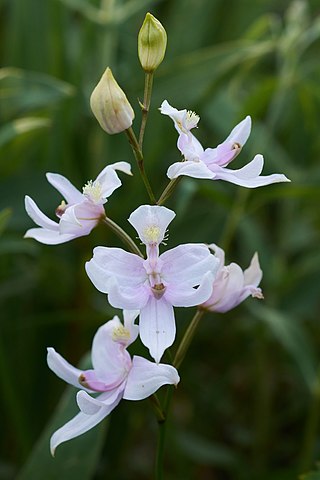
Calopogon oklahomensis, commonly known as the Oklahoma grass pink or prairie grass pink, is a terrestrial species of orchid native to the United States. It is restricted to the states of Alabama, Arkansas, Georgia, Illinois, Indiana, Iowa, Kansas, Louisiana, Minnesota, Mississippi, Missouri, Oklahoma, South Carolina, Tennessee, Texas, and Wisconsin. It is extirpated throughout most of its range. Calopogon oklahomensis is a perennial herb with flowers that are white, pink or purple, with a labellum with an apical region of yellow hairs. Flowers bloom March to July. Its habitats include coastal prairies, savannas, edges of bogs, and oak woodlands. It was described by Douglas H. Goldman in 1995.

Coreopsis tinctoria, commonly known as plains coreopsis, garden tickseed, golden tickseed, or calliopsis, is an annual forb. The species is common in Canada, northeast Mexico, and most of the United States, especially the Great Plains and Southern States. The species is also widely cultivated and naturalized in China.

Liatris aspera is a perennial wildflower in the Asteraceae family that is found in central to eastern North America in habitats that range from mesic to dry prairie and dry savanna.

Desmodium canadense is a species of flowering plant in the legume family, Fabaceae. It is native to eastern North America. Its common names include showy tick-trefoil, Canadian tick-trefoil, and Canada tickclover.

Phlox pilosa, the downy phlox or prairie phlox, is an herbaceous plant in the family Polemoniaceae. It is native to eastern North America, where it is found in open areas such as prairies and woodlands.

Lithospermum canescens, or the hoary puccoon is a perennial herb endemic to eastern North America. The plant grows in a variety of habitats. It has golden yellow flowers which bloom from April to May.

Viola adunca is a species of violet known by the common names hookedspur violet, early blue violet, sand violet, and western dog violet. It is native to meadows and forests of western North America, Canada, and the northern contiguous United States.
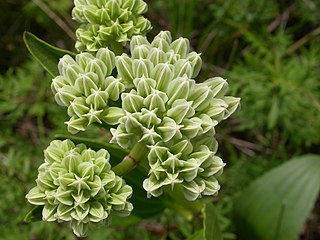
Arnoglossum plantagineum also known as tuberous Indian-plantain, groovestem Indian plantain or prairie Indian plantain, is a North American species of Arnoglossum in the sunflower family. The Latin specific epithet plantagineum refers to the leaves of the plant which are similar to those of a plantain.

Tephrosia virginiana, also known as goat-rue, goat's rue, catgut, rabbit pea, Virginia tephrosia, hoary pea, and devil's shoestring is a perennial dicot in family Fabaceae. The plant is native to central and eastern North America.

Liatris cylindracea is a plant species in the family Asteraceae. It is native to eastern North America, where its populations are concentrated in the Midwestern United States. It is found in habitats such as prairies, limestone and sandstone outcroppings, bluffs, barrens, glades, woodlands and dunes.

Penstemon grandiflorus, known by the common names shell-leaved penstemon, shell-leaf beardtongue, or large-flowered penstemon, is a tall and showy plant in the Penstemon genus from the plains of North America. Due to its large flowers it has found a place in gardens, particularly ones aimed at low water usage like xeriscape gardens.
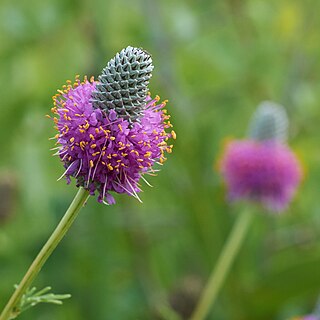
Dalea purpurea is a species of flowering plant in the legume family known as purple prairie clover. Native to central North America, purple prairie clover is a relatively common member of the Great Plains and prairie ecosystems. It blooms in the summer with dense spikes of bright purple flowers that attract many species of insects.

Liatris punctata is a species of flowering plant in the family Asteraceae known by the common names dotted gayfeather, dotted blazingstar, and narrow-leaved blazingstar. It is native to North America, where it occurs throughout the plains of central Canada, the central United States, and northern Mexico.

Helianthus petiolaris is a North American plant species in the family Asteraceae, commonly known as the prairie sunflower or lesser sunflower. Naturalist and botanist Thomas Nuttall was the first to describe the prairie sunflower in 1821. The word petiolaris in Latin means, “having a petiole”. The species originated in Western United States, but has since expanded east. The prairie sunflower is sometimes considered a weed.
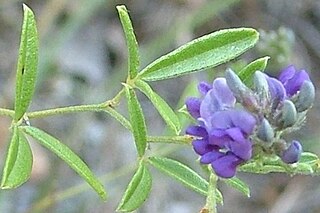
Pediomelum tenuiflorum, the slimflower scurfpea, is a perennial in the pea family. It is about 2–3 feet (0.6–0.9 m) tall and has a lot of leaves on top. Its leaves can reach a length of 3 inches (80 mm). This flower can be found mainly in the central and southwestern U.S.

Orbexilum pedunculatum, commonly known as Sampson's snakeroot, is a species of flowering plant in the legume family. It is native primarily to the Southeastern United States where it is found in prairies and savannas, often in acidic soil. It is a perennial that produces racemes of flowers in early summer.
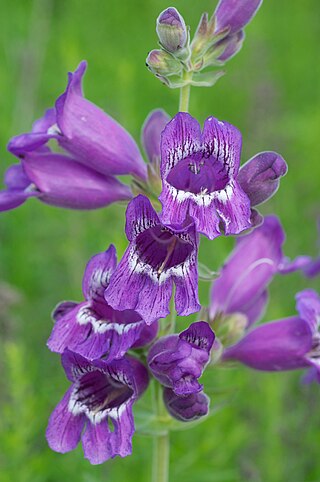
Penstemon cobaea is a flowering plant in the plantain family, commonly known as Cobaea beardtongue, prairie penstemon or foxglove penstemon. The plant is native to the central United States, primarily the Great Plains from Nebraska to Texas, with additional populations in the Ozarks of Missouri and Arkansas. There are also populations reported in the southwestern United States as well as in Illinois and Ohio, but these appear to be introductions.

Asclepias hirtella, commonly called the tall green milkweed, is a species of flowering plant in the milkweed genus and dogbane family (Apocynaceae). It is native to Canada and the United States, where its range is concentrated in the Midwest and Upper South.

Astragalus crassicarpus, known as ground plum or buffalo plum, is a perennial species of flowering plant in the legume family, Fabaceae, native to North America. It was described in 1813. The fruit is edible and was used by Native Americans as food and horse medicine. It is a host of afranius duskywing larvae. It is also known as groundplum milkvetch and pomme de prairie.

Physaria ludoviciana is a species of flowering plant in the mustard family Brassicaceae, with the common names of bladder pod, silver bladderpod, louisiana bladderpod, and foothill bladderpod. It used to be Lesquerella ludoviciana which is now a synonym.




















